Superstars of industrial reuse
By Janet Bebb, May 20 2015
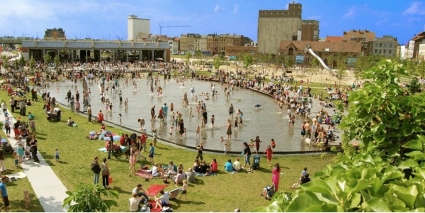 In the fall, Intertwine Alliance Executive Director Mike Wetter asked if I would go to Philadelphia for a forum on reusing industrial lands for parks. It seemed like a good idea at the time, but when February came around and it was in the teens in Philadelphia — plus the hosting group was the German Marshall Fund — I had some doubts. Wasn’t the German Marshall Fund put to bed with World War II?
In the fall, Intertwine Alliance Executive Director Mike Wetter asked if I would go to Philadelphia for a forum on reusing industrial lands for parks. It seemed like a good idea at the time, but when February came around and it was in the teens in Philadelphia — plus the hosting group was the German Marshall Fund — I had some doubts. Wasn’t the German Marshall Fund put to bed with World War II?
It was, in fact, very cold — and also totally interesting. The German Marshall Fund Trans-Atlantic Cities Network indeed has its roots in the WWII reclamation plan, but with a current spin: bringing together experts from cities similar in size to Portland for workshops and problem solving. This particular forum was designed as “a transatlantic conversation around innovative strategies for the reuse of Philadelphia’s underutilized urban infrastructure, with a specific focus on public space and adaptive reuse of civic architecture.”
Participants were from Portland; San Antonio; New York; Torino, Italy; Rotterdam, The Netherlands; Antwerp, Belgium — and all were ready to work from 7 a.m. to after hours to help problem solve. From a Portland orientation, the most interesting examples brought to the table were from Rotterdam and Antwerp, as well as from Philadelphia. We can take a lesson from their innovations.
Unlikely partnerships
 Gabrielle Muris, a charming and dynamic project director/developer with the Rotterdam Centre for Resilient Delta Cities, spoke about the reuse of industrial buildings at the Port in Rotterdam, one of the largest ports in the world. Technology had rendered many buildings obsolete and ripe for reuse — but as what? Big warehouse-type space out at an industrial site seemed to raise more questions than suggest answers. Abandoned, cavernous and singularly unpromising, the space became home to startling innovation.
Gabrielle Muris, a charming and dynamic project director/developer with the Rotterdam Centre for Resilient Delta Cities, spoke about the reuse of industrial buildings at the Port in Rotterdam, one of the largest ports in the world. Technology had rendered many buildings obsolete and ripe for reuse — but as what? Big warehouse-type space out at an industrial site seemed to raise more questions than suggest answers. Abandoned, cavernous and singularly unpromising, the space became home to startling innovation.
The solution evolved over time. The buildings have been transformed into a campus based on jobs and innovation. One by one, partners came to the table. Technical/industrial educators partnered with emerging businesses to provide students a chance to get their hands into specific new projects. The port saw this as an opportunity to solve technical problems and incubate a future, innovative work force.
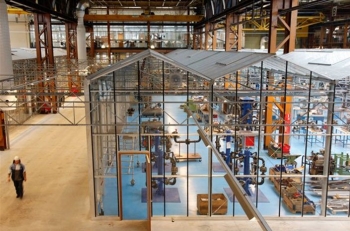 Design interest kept pace with the creative partnerships. To give each emerging business/student group an identity, glass “pods” were inserted into the massive warehouse structure. See for yourself, and enjoy the Dutch.
Design interest kept pace with the creative partnerships. To give each emerging business/student group an identity, glass “pods” were inserted into the massive warehouse structure. See for yourself, and enjoy the Dutch.
How to build a park for many cultures?
Ellen Lamberts, a sociologist and spatial planner at AG VESPA Antwerp, spoke about the reconversion of an old railway yard in Antwerp to a brand-new city park called Park Spoor Noord. The process took eight years, and is an interesting case study of rebuilding a void in the urban fabric to become a successful "place to be.”
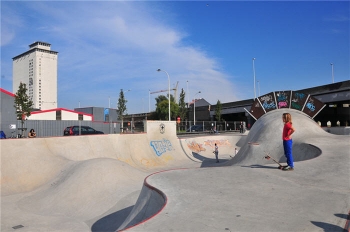 The park was very well-funded and includes play areas and spectacular biking and skate-boarding facilities. But, according to Ellen, one of the keys to success was understanding that the cross-cultural groups in the surrounding neighborhoods wanted unprogrammed space where they could be themselves with their friends, families and communities. It’s an impressive park in terms of facilities – which we in The Intertwine also spend a lot of time and money on – but primarily it’s a place where people from different cultures can be themselves.
The park was very well-funded and includes play areas and spectacular biking and skate-boarding facilities. But, according to Ellen, one of the keys to success was understanding that the cross-cultural groups in the surrounding neighborhoods wanted unprogrammed space where they could be themselves with their friends, families and communities. It’s an impressive park in terms of facilities – which we in The Intertwine also spend a lot of time and money on – but primarily it’s a place where people from different cultures can be themselves.
Can green infrastructure and parks planners be partners?
Of course, in Portland, we have any number of examples where this works. Portland Parks and Recreation commonly creates bioswales and accepts run-off from streets, and Portland’s Bureau of Environmental Services and Bureau of Planning and Sustainability include PP&R in projects such as Johnson Creek flood storage. Did I mention the Water Bureau? While episodes of great coordination do happen here in The Intertwine, we often separate these topics, and the silos are fairly distinct.
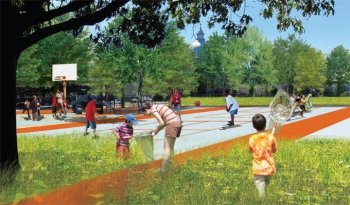 Philadelphia – also with a large city bureaucracy – has opened the channels for these topics and their respective practitioners to join together. I was impressed by the Philadelphia city staff at the forum and their assumption of coordination across topics. Some key documents have woven the topics together.
Philadelphia – also with a large city bureaucracy – has opened the channels for these topics and their respective practitioners to join together. I was impressed by the Philadelphia city staff at the forum and their assumption of coordination across topics. Some key documents have woven the topics together.
- Green City, Clean Waters, 2011, is a 25-year plan to protect and enhance watersheds. In addition to planning for effective green treatment of storm water, the plan also supports a large-scale street tree program and increased access to open space.
- GreenPlan Philadelphia, 2006: An interagency management team met regularly to coordinate seemingly diverse topics as storm water, economic development, and health and environmental issues. The development of trails was a key recommendation, with the goal of a trail within ½ mile of every resident.
- Green2015: An Action Plan for the First 500 Acres. Launched in 2010, this plan was developed from GreenPlan Philadelphia to meet the administration’s goal of developing 500 acres of parks from vacant land by 2015.
Four days with experts in reuse of industrial lands in the freezing cold weather was indeed inspiring, with unexpected visions of unlikely partners building beautiful and innovative projects.

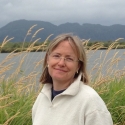 Janet Bebb keeps hoping the Portland region will become a place where people and nature coexist gracefully. A landscape architect with 13 years at Portland Parks and Recreation and 7 years at Metro, she’s put quite a bit of effort behind the hope. With her current part-time work at The Intertwine Alliance, she continues the quest.
Janet Bebb keeps hoping the Portland region will become a place where people and nature coexist gracefully. A landscape architect with 13 years at Portland Parks and Recreation and 7 years at Metro, she’s put quite a bit of effort behind the hope. With her current part-time work at The Intertwine Alliance, she continues the quest.
Comments
Appreciative learner
Inspiring and thoughtful. Can
Reimagining Beauty
Add new comment